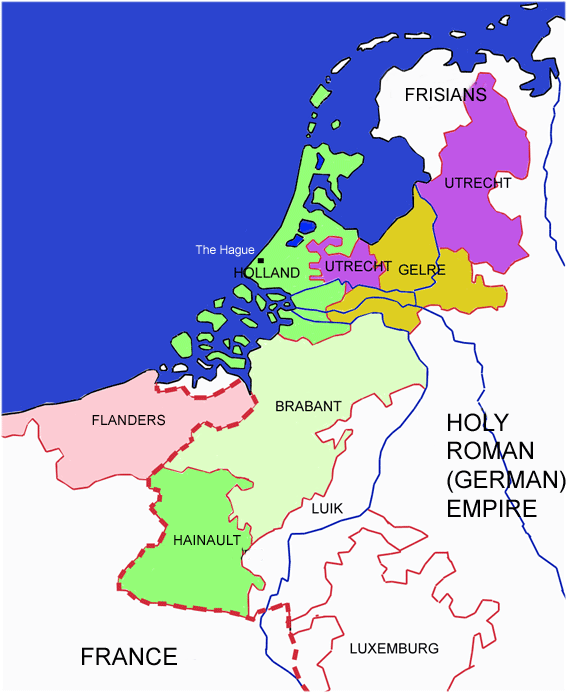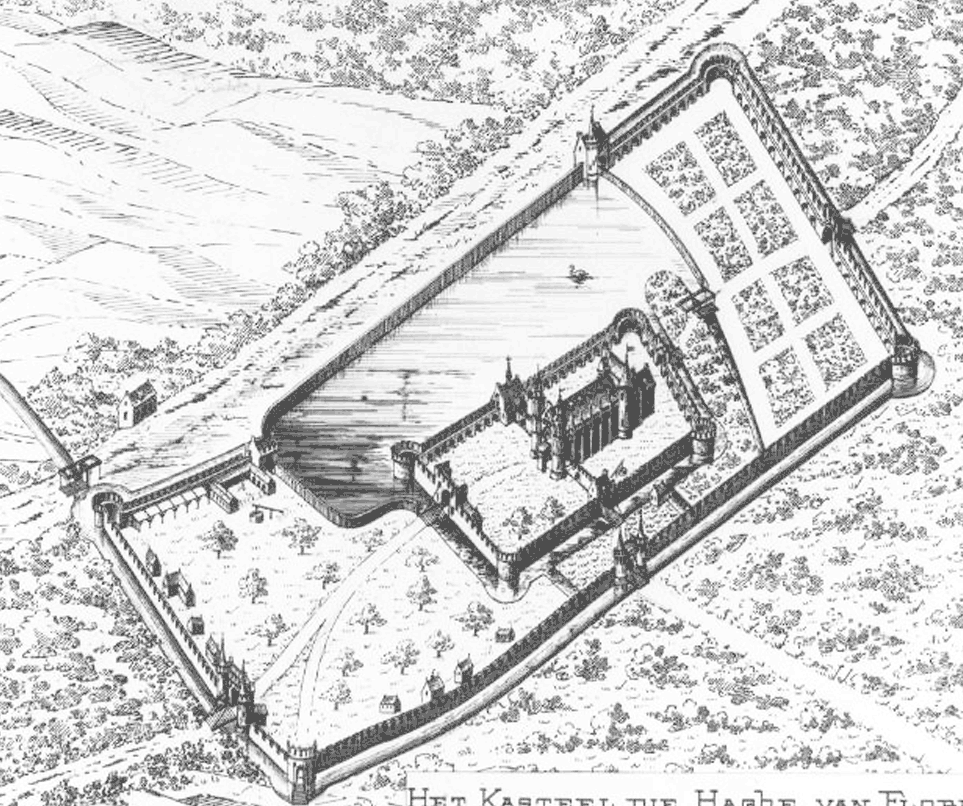
 Website on the history of The Hague.
Website on the history of The Hague.
Most visited pages (till now only in Dutch):

Short history of The Hague
Prehistory
Like many histories, the history of The Hague starts in Prehistory. That is the period before men could write and therefore we don’t have any written records. In one of the inland quarters, Ypenburg, archaeologists found the remains of an iron-age settlement, dated around 3500 BC. People lived here on dunes on the coastline, which was located much more inland in this period. The area of The Hague was part of the ‘North Sea’.

The four prehistoric sandy ridges in the region of The Hague.
Around 3500 C the coastline extended to an even more inland sandy ridge at Ypenburg. The dotted green line is the high moorland which grew later and then extended all the way to Utrecht. Between the ridges (in green) was marshy territory.
Romans
Just before the start of our era the Romans arrived in our region. The northern part of the Europee was sparsely inhabited by a few German tribes. The Romans did not succeed in conquering these Germans and they withdrew behind one of the large rivers in this region, the Rhine. The estuary of the Rhine then was near Katwijk, to the north of The Hague and so the region of The Hague became part of the Roman frontier fortifications. The Romans established their regional capital in the present city of Voorburg and called it Forum Hadriani, the marketplace of Hadrian. The Romans lived here for some centuries before they pulled back to the south. Presumably, only a handful of Germans remained in this region, though we do not have any information about them. We only know that centuries later some farmers lived in the centre of The Hague. Archaeologists found traces of old farmland near the Annastraat.

The area around The Hague in Roman times.
In yellow the sandy ridges or dunes, in green the peat area. The northern frontier of the Roman Empire was the 'Oude Rijn'. The regional capital of the Romans was Forum Hadriani, near current Voorburg. A is the Scheveningseweg, the place were the remains of a Roman guard post was excavated.
Counts of Holland
The history of The Hague actually starts in the hamlet of Loosduinen where the counts of Holland built their first house in this region. Counts ruled here more than a thousand years ago when former civil servants of the German emperor gained some local independence, especially eccentric areas as Holland. Holland was only the western part of the country that now is The Netherlands. The independency of the counts was challenged by the German emperors, but also contested by other minor lords in this region. The counts had to travel around to rule the different parts of their county, to administer justice and collect taxes. In those early and unruly times they did not have one central residency, but they had houses all over their county.
In this region they had houses in ‘s-Gravenzande, Leiden en in Loosduinen they had their ‘villa Losdun’. Their is not much information about this house. In 1186 count Dirk VII used it to marry Aleida van Kleef. Only some fifty years later another record mentions this house. In 1228 countess Machteld established a convent in Loosduinen and two years later count Floris IV gives his ‘villa’ in ‘Losdun’ to the nuns. Evidently he does not live anymore in Loosduinen and we can presume that he moved from there to The Hague. Many historians believe that in 1229 he bought an estate at the location of the present Binnenhof. Around 1229 the count and his family then presumably moved to The Hague.

The area around The Hague in Roman times.
In yellow the sandy ridges or dunes, in green the peat area. The northern frontier of the Roman Empire was the 'Oude Rijn'. The regional capital of the Romans was Forum Hadriani, near current Voorburg. A is the Scheveningseweg, the place were the remains of a Roman guard post was excavated.
A ‘royal’ palace
The year 1247 was an important year for count Willem II (William II). The county of Holland belonged to the German empire in which there was an enduring struggle for the imperial throne. The emperor was elected by the highest counts and in 1247 many of them found Willem II a suitable candidate. He was not meant to be a very powerful ruler in the German Empire, but the first year he had to fight his contender. In 1248 he could visit his county Holland for the first time. In that year legend has it that he decided to build a ‘regale palacium’, a royal palace, at the present location of the Binnenhof. A royal palace was a large building like a Hall of Knights with some surrounding buildings. Presumably, a large number of monks started building this house, but Willem did not live long enough to see his hall finished. On a campaign to ever-turbulent Western Frisia he died in an unfortunate way.
The famous Ridderzaal (Hall of Knights)
When his infant son Floris V came of age he continued with the castle. He did however put down the old hall of his father, and started on building a new and larger hall, the largest in Europe. This Hall of Knights was formidable and admired by foreigners, even centuries later. Floris’ Ridderzaal was build to show the ambitions of Floris of Holland. His ancestors were the legendary kings of Frisia, and his father had been a king of the empire. Floris did not succeed to become king of Scotland, as he is said to have aspired, but in his own county he had more power than before. Floris is said to have been popular with the common man. The English king Edward III tried to de-stabilise his government by inciting minor nobles against count Floris. The nobles kidnapped Floris V, but in the ensuing pursuit they killed the count.
In the time of Floris the castle in The Hague (the castle never had a specific name) was extended with other buildings and moats. It became a rather large castle with a large forecourt and an inner court with several gardens. The castle was surrounded with walls and moats, but it was not a heavy fortified castle. The walls and moats were only thereto provide some basic security.
Counts of Hainault
Floris V left a young and feeble son behind that died at a young age. By then the county of Holland was controlled by his uncle Jan, who had married his aunt. Jan was count of Hainault, a region on the border of France. Jan became the first part-time ruler of Holland. Their main interests lay in Hainault, but they came during the winter time to Holland. These counts also had to travel through their counties to maintain order and suppress any upcoming revolt. In time the administration became more elaborate and extensive so the court settled in one place. Their northern residency became the castle of The Hague.
There they kept their archives and there lived their household. The count was always traveling through his counties or in the German empire or neighboring countries. The counts of Holland tried to have good relations with the kings of England and France, and Willem III (William III) succeeded in marrying off his daughters to the emperor and two kings. He had the epithet ‘father-in-law of Europe’ and was very influential.
The household of counts of Hainault was not very large and consisted of a few dozen people. But they took most of their belongings with them in heavy carts and had to be in The Hague before winter closed in and they could not use the dirt roads.
The Binnenhof was not their most important residency, but the counts of Hainault still found it necessary to enlarge the castle. They extended the living accommodation.

The Binnenhof in the days of count Floris of Holland.
Reconstruction of the castle of The Hague in the days of count Floris V. The largest building is the Ridderzaal (Hall of Knights). It is the only building in the drawing that still exists. The reconstruction is not up-to-date with more recent research, but it still gives an idea of how The Hague looked like around 1400 or 1450 (Haags Gemeentearchief)
Village of The Hague
On the northern and western side of this extensive castle the village of The Hague developed, because the castle attracted people that needed a place to live. In the first place the new people were noblemen or members of the gentry who worked for the count or were his advisors. They had their castles in the country, but also wanted a stately house nearby. Their houses looked like castles, with walls and merlons, but they did only had an aesthetic function. They were meant to impress. Their houses were built everywhere in The Hague, but especially in the area near the Gevangenpoort, the main entrance of the castle.
Secondly the new people were commoners who started to live in the part of The Hague that became a village of its own. The village got its own parish church in 1275, but a civil administration of its own was a different matter. The Hague was not allowed to have its own administration. Large towns were granted all sorts of judicial, economic and administrative rights so that they could build a city wall and have their own civic guard. The count did not like city walls and an independent minded civic guard close to his residency and never granted The Hague its own charter. In time The Hague became too large to be administrated as a village, and The Hague was allowed some of the rights that were granted to cities. But The Hague never got the right to call itself a city in the legal sense.
Complex administration
(still in preparation, January 2010)

The area around The Hague in Roman times.
In yellow the sandy ridges or dunes, in green the peat area. The northern frontier of the Roman Empire was the 'Oude Rijn'. The regional capital of the Romans was Forum Hadriani, near current Voorburg. A is the Scheveningseweg, the place were the remains of a Roman guard post was excavated.
© For non commercial use you may use text of this site with acknowledgment of sources or a link to these pages. Pictures without credits are mine and may also be used.
Suggestions of any kind and tips about language errors are very much appreciated. Reaction.